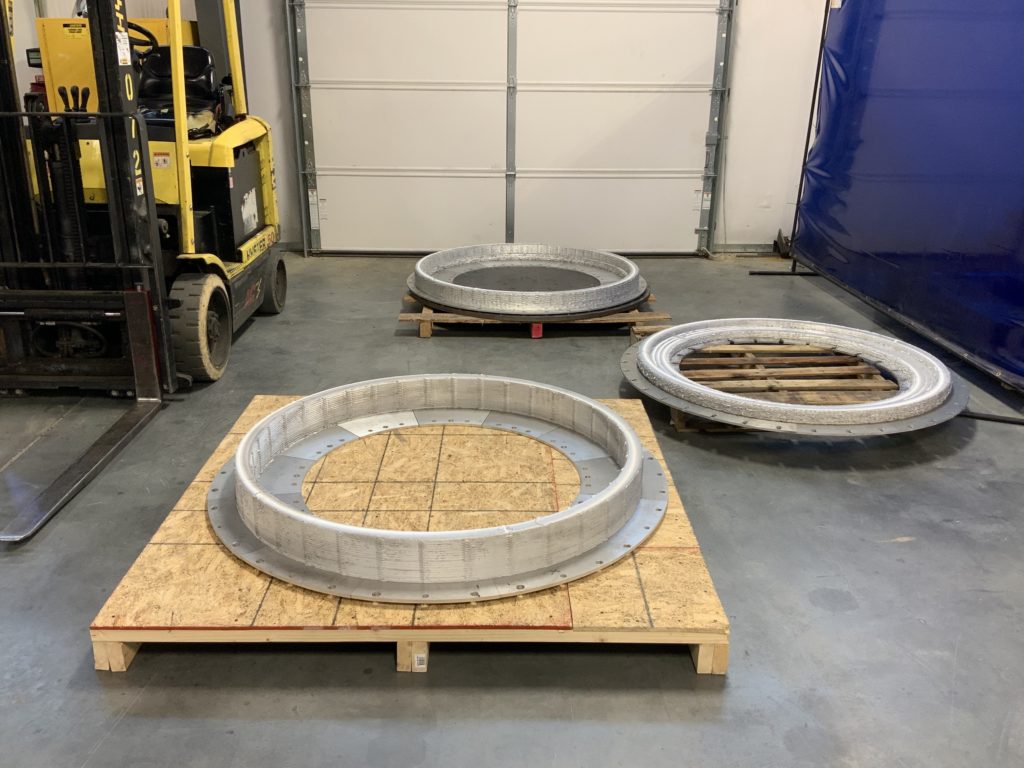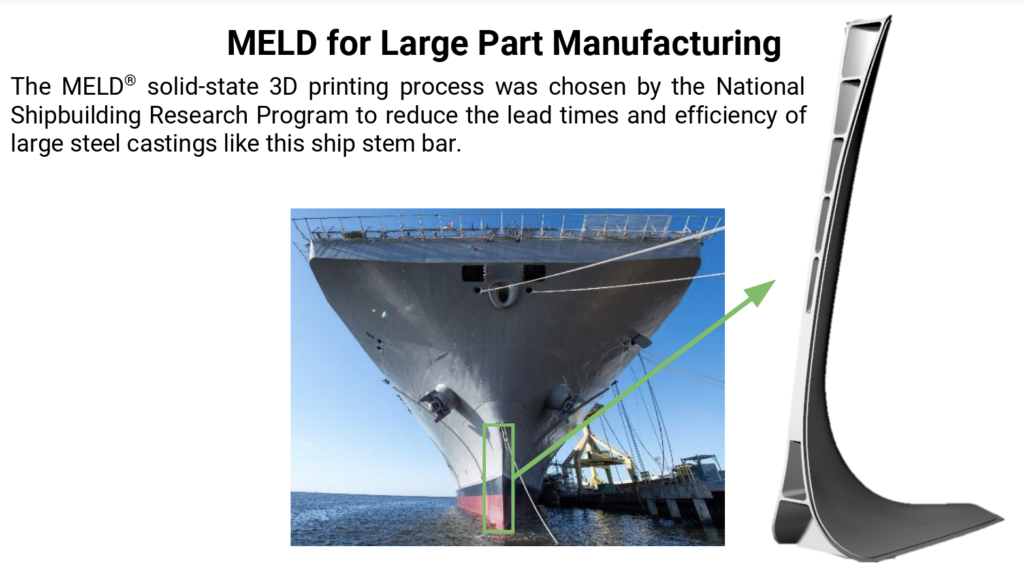It was a big day at MELD when the firm obtained $1.5 million from the U.S. Navy for maintenance and repair operations (MRO). MELD 3D printing is similar to a friction stir 3D printing process—only, here, friction heats metal bar feedstock to below its melting point and new material is added. By skipping the melting and not performing any sintering, MELD parts have better properties than other processes can achieve. Finishes are rough, but you can build very large components without the need for an enclosed build chamber and you don’t have problems with thermal stresses distorting parts.
The grant aims to help qualify MELD machines and parts for the Navy and lead to 3D printing operations at shipyards. The aim is to repair legacy parts and also to print new geometries and upgrades for vessels. The company states, “The L3 machine will provide the Navy with flexibility to use multiple materials and preserves the ability to create and repair parts with newly designed alloys.”

Dr. Chase Cox, MELD’s Director of Technology, said of the news:
“We’ve received requests for a number of parts in a wide range of metal alloys from the Navy and shipbuilders that are not able to be printed with any other technology. The range of need expressed to us really highlights the value of a MELD machine, because unlike other metal printers, MELD can print metals the Navy truly needs at a size that is not otherwise possible.”
MELD CEO Nanci Hardwick added: “MELD solves the global problem of long lead times for forged and cast metal products and provides large scale components in all metals.”

At the moment, MELD can be used to create dense parts that are several meters in length and, theoretically, the technology can be used for much larger items. MELD can also be used to join two metals or to rejuvenate parts by adding material on top of a used component. MELD is very versatile in terms of the feedstock it needs, which also makes the process much more economical for large parts.
Given that the scale at which the NAVY operates, it needs to have economical technologies that make large parts that are deployable globally. Finicky powder bed fusion feedstock, which needs to be kept under stringent conditions would complicate matters, especially since the material is often ten to fifty times more expensive than the same material in another form. MELD also can work without powder at all, which is is surely of interest to the seafaring folk.

MRO is a huge problem for the Navy. Only three of a sample of 24 ships were repaired on time; overseas and in the states, there is a maintenance backlog. There are shortages of staff and delays overseas, as well. Submarines are returning to the fleet seven months too late. Meanwhile, their existing repair infrastructure is “crumbling” and they will invest $21 billion in upgrading those facilities. The Navy spends over $12 billion a year on maintenance, too.
Yeah, let’s all continue to grovel before that one guy at Boeing for some scraps. Let’s ignore this fantastically huge opportunity. We’ve written before on the opportunity in marine spare parts. Ivaldi is looking into it, along with Singapore, Wilhelmsen and Thyssen. Besides that, there is precious little activity in maritime 3D printing worldwide. MELD seems ideally placed to helping the Navy with its maintenance problem.
The Navy has also been talking about putting 3D printers on ships for a long time now. This prospect has terrified me because few things like to catch fire or explore more readily than titanium and other metal powders. At the same time, fires in powder bed fusion machines can be a problem and powders can ignite in storage, during printing and in post-processing. And fire is one of the scariest, most lethal phenomena aboard a ship. And that nicely laid flat powder bed hasn’t yet started to shift because of the ship moving. With MELD there are fewer obstacles for shipboard 3D printing.
3D printing on the go could really help the U.S. Navy deploy more ships simultaneously. The use of 3D printers at naval repair centers in Spain, Japan, Singapore, and Bahrain would also really help accelerate the repairs of the ships stationed or passing through those areas. In case of a conflict, MELD printers could also be deployed to the nearest U.S. base to enact local repairs, as well. With many alloys possible on MELD systems, these machines could be used across many applications. On-site 3D printing would also let the Navy upgrade vessels on location in the face of emerging threats, for example. All in all, great news for MELD and a huge boost for 3D printing in a far-too-neglected area.
Subscribe to Our Email Newsletter
Stay up-to-date on all the latest news from the 3D printing industry and receive information and offers from third party vendors.
You May Also Like
3D Printing News Briefs, April 13, 2024: Robotics, Orthotics, & Hypersonics
In 3D Printing News Briefs today, we’re focusing first on robotics, as Carnegie Mellon University’s new Robotics Innovation Center will house several community outreach programs, and Ugogo3D is now working...
3D Printing Webinar and Event Roundup: March 24, 2024
We’ve got a very busy week of webinars and events, starting with Global Industrie Paris and a members-only roundtable for AM Coalition. Stratasys will continue its advanced in-person training and...
MIMO TECHNIK, ASTRO Test Lab & LEAP 71 Combine Powers for Computational Engineering in Aerospace 3D Printing
California-based MIMO TECHNIK, a service bureau catering to demanding clients in the New Space and defense sectors, operates with six SLM 500s, four SLM 280s, and three SLM 125s. ASTRO...
EOS Taps 1000 Kelvin for “First” AI Co-pilot for 3D Printing
Additive manufacturing (AM) startup 1000 Kelvin has joined forces with EOS to integrate AMAIZE, a pioneering artificial intelligence (AI) co-pilot for AM, into the EOS software suite. The solution aims...





























